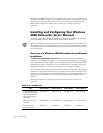
5-2 User’s Guide
Configuring the LUNs and RAID Level for the Shared
Storage Subsystem
The storage system hard-disk drives must be bound into logical unit numbers (LUNs)
using the Dell OpenManage Data Supervisor or Dell OpenManage Data
Administrator.
All LUNs, especially the LUN used for the Microsoft Cluster Server (MSCS) quorum
resource, should be bound using a redundant array of independent disks (RAID) level
to ensure high availability. See “Cluster Quorum Resource“in Chapter 6, “Configuring
the System Software” for more information on the quorum resource.
NOTICE: Dell recommends that you use a RAID level other than RAID 0 for
your PowerVault shared storage system. RAID 0 does not provide the level
of availability required for the quorum resource. See the Installation and
Troubleshooting Guide for your PowerVault storage system for more infor-
mation about setting up RAID levels for the system.
Configuring Internal SCSI Hard-Disk Drives
If you have added new hard-disk drives to your cluster node or you are setting up the
internal drives in a redundant array of independent disks (RAID) configuration, you
must configure the RAID before you can install the operating system. For instructions
on setting up the internal drives, see the appropriate small computer system interface
(SCSI) controller or RAID controller documentation for your system.
RAID Level for the Internal SCSI Hard-Disk Drives
Configure the hard-disk drives using the RAID controller's basic input/output system
(BIOS) configuration utility. For optimum balance of fault tolerance and performance
with a limited number of drives, the recommended configuration for the internal
drives is RAID 1.
NOTE: Most of the RAID hard-disk drives should be in the shared storage system.
For more information on RAID configurations, see the documentation for your specific
PowerEdge RAID controller.


















